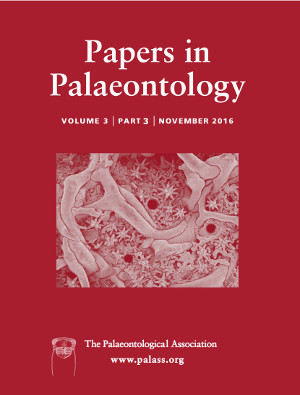Reg. Charity No. 1168330

Caryosyntrips appendages have previously been reported from the Burgess Shale (Cambrian, Stage 5), British Columbia, Canada. New specimens of the genus are here reported from the Wheeler Formation (Cambrian, Drumian) and Langston Formation, Spence Shale Member (Cambrian, Stage 5), Utah, USA. The original Burgess Shale specimens are re-examined alongside the new specimens. Caryosyntrips is shown to have paired ventral spines on each podomere. Three species of Caryosyntrips are recognized: C. serratusDaley & Budd, C. camurus sp. nov. and C. durus sp. nov., differentiated by the overall shape of their appendages and arrangement of dorsal and ventral spines. These differences have potential implications for the feeding methods employed by different species of Caryosyntrips. A specimen collected from the upper Valdemiedes Formation of Spain (Cambrian, Stage 4), previously described as the lobopodian Mureropodia apae Gámez Vintaned et al., is reinterpreted as a Caryosyntrips appendage. This identification is supported by the overall shape of the fossil, and the presence, orientation and length:width ratio of ventral spines. However the dorsal surface of the appendage is not well preserved, and the appendage and its ventral spines are larger than those of other known Caryosyntrips. Therefore it is left in open nomenclature as C. cf. camurus. These new finds increase the temporal range of Caryosyntrips (Cambrian Series 2, Stage 4 to Series 3, Drumian) and the geographical range to a new continent: Gondwana.